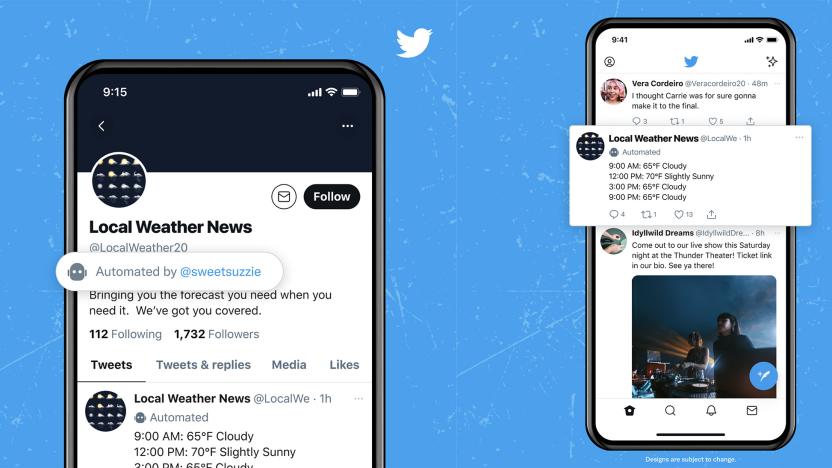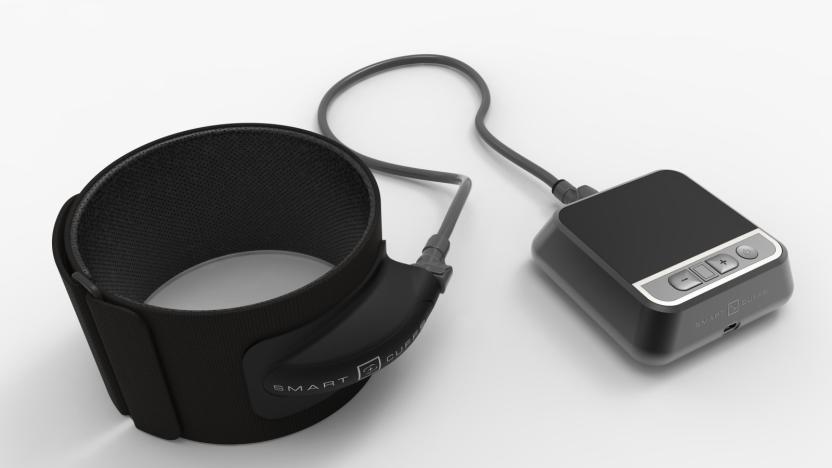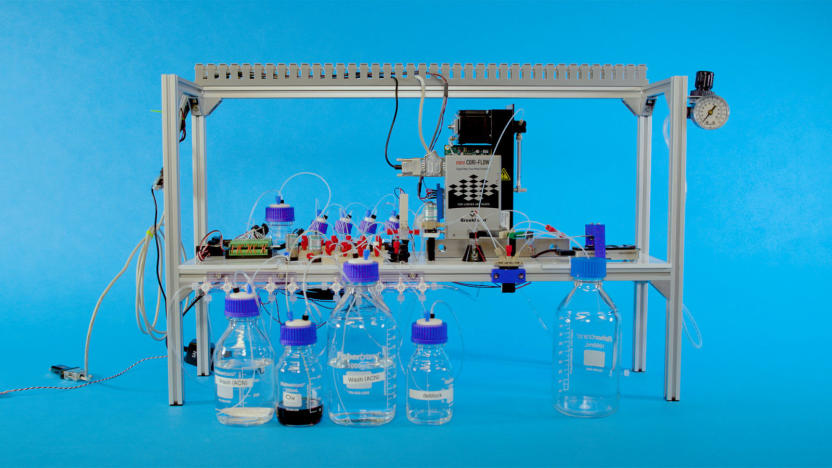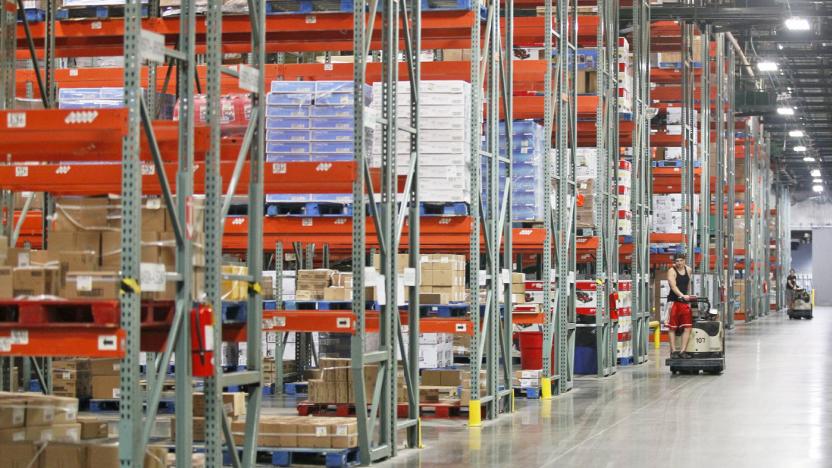automated
Latest

Twitter tests a way for accounts to let people know they're bots
Twitter is testing a new label that lets automated bot self-identify as such in their labels.
Steve Dent09.10.2021
YouTube will temporarily increase automated content moderation
YouTube will rely more on machine learning and less on human reviewers during the coronavirus outbreak. Normally, algorithms detect potentially harmful content and send it to human reviewers for assessment. But these are not normal times, and in an effort to reduce the need for employees and contractors to come into an office, YouTube will allow its automated system to remove some content without human review.
Christine Fisher03.16.2020
SmartTools' updated weight lifting cuffs are cheaper and more durable
Bench pressing 200 pounds is cool, if you're into that, but it can put a strain on your limbs. SmartTools has an alternative. The company's SmartCuffs, blood flow restriction training (BFR) cuffs, let you lift less weight and see the same gains. While BFR training has primarily been used in clinical settings, the new SmartCuffs are meant for consumers and they're significantly more affordable than past iterations.
Christine Fisher01.05.2020
Google Pixel phones can use text-to-speech to talk to 911 for you
In the event of an emergency, your first instinct might be to call 911. But in certain situations, you may not be able to speak with an operator. Whether that's because you're injured, in a dangerous situation or have a speech impairment, Google wants to make sure its users can request the help they need. Today, it introduced a new feature that lets you send automated voice messages with a single tap.
Christine Fisher08.01.2019
Amazon might start using robots to box your orders
A few weeks ago, Amazon said it will be at least 10 years before the company is running fully-automated warehouses. But partial automation is already underway. According to Reuters, Amazon is considering installing two machines at dozens of warehouses that have the potential to replace at least 24 jobs at each location. If Amazon were to roll the machines out across its 55 US fulfillment centers for standard-sized inventory, that could lead to more than 1,300 job cuts.
Christine Fisher05.13.2019
Microsoft device stores digital info as DNA
Microsoft is on its way to replacing data centers with DNA. The company and researchers from the University of Washington have successfully automated the process to translate digital information into DNA and back to bits. They now have the first, full end-to-end automated DNA storage device. And while there's room for improvement, Microsoft hopes this proof-of-concept will advance DNA storage technology.
Christine Fisher03.21.2019
Pioneer’s latest DJ controller adds push-button ‘scratching’
With the advent of more powerful software and controllers, modern DJs really don't need to learn as much about spinning tracks as they used to. Now beginners are treated to automated cues, loops and beat matching software that take some of the art out of DJing. The latest bit of automation comes from Pioneer and its $249 DDJ-SB3 DJ controller. The unit adds a Pad Scratch feature that gives aspiring club monsters the ability to imitate eight different scratch techniques that were recorded by DJ Jazzy Jeff. Whatever track you're playing, the scratch will automatically match up with the right tempo with a simple tap on a performance pad.
Rob LeFebvre03.01.2018
US DOT outlines safe transition to self-driving cars
US legislation for self-driving cars first made its way to the House of Representatives this past July. The bipartisan SELF DRIVE Act passed the House vote on September the 6th, and will now need to go through the Senate. Odds are that we'll see autonomous cars on the road sooner rather than later, thanks to this bill and new voluntary guidance The US Department of Transportation and the National Highway Traffic Safety Administration (NHTSA). The governmental agencies released new guidelines on Tuesday that provide federal guidance for automated driving systems to both individual states and businesses.
Rob LeFebvre09.12.2017
Walmart trials stock-checking drones in its warehouses
Few jobs are more monotonous than counting inventory all day, every day. Maybe that's why Walmart is thinking about farming the job out to drones. The retailer is running tests to see if camera equipped drones can help speed up inventory counts in its distribution centers. So far, results are promising -- during a recent demo of the technology, Walmart said that the drones could potentially do a month's worth of human labor in a single day.
Sean Buckley06.03.2016
The Associated Press is automating college sports news, too
In an effort to bring the masses more sports news, the Associated Press plans to use automated tech for stories it wouldn't normally cover. The AP is working with the NCAA this spring to produce game reports across Division I baseball, Division I women's basketball and both Division II and III football. In the months to come, coverage will extend to Division II and III men's basketball -- probably just in time for next season. While the NCAA will provide the game stats, stories will leverage the tech that the AP already uses to automate thousands of earnings reports each quarter. "This will mean thousands of more stories on the AP wire, which will remain unmatched in the industry," said Barry Bedlan, the AP's deputy director of sports products. "Every college sports town will have some level of coverage." Local news outlets will certainly tap into the new feed, so hopefully small town beat reporters won't have to find a new niche. [Image credit: Ethan Hyman/Raleigh News & Observer/MCT via Getty Images]
Billy Steele03.04.2015
The Associated Press welcomes its robot journalist overlords
Robots are cool and all, but they're just mere toys until they start doing things like reporting the news, right? (Okay, we may be looking at the prospect somewhat selfishly.) Fortunately, that's already starting to take place -- to a degree. In July, the Associated Press will begin using an automated service capable of churning out up to 4,400 business stories. With the help of a company called Automated Insights, these articles will include numerous pieces on quarterly earnings reports, which in theory should free up the humans to do the deeper stuff, such as pieces on why the numbers actually matter and what the executives say during their calls to investors.
Brad Molen06.30.2014
MIT and Stanford will teach Ford's automated cars how to dodge obstacles
It's not enough for Ford to build automated test cars; it also has to teach those cars how to handle the road. To that end, the automaker is partnering with MIT and Stanford on research projects that will help automated (and eventually, autonomous) vehicles avoid obstacles. MIT is investigating ways to predict the movements of both pedestrians and other drivers, letting a smart car find a clear path around any hazards. Stanford, meanwhile, is developing sensor technology that could peek around big rigs and other objects that block the view ahead. It may be a long while before either project bears fruit, but the work could lead to Ford cars that deal with many emergencies by themselves.
Jon Fingas01.22.2014
Ford's Fusion Hybrid research car will explore our driverless future
Ford is convinced that autonomous cars are the future, and it's putting its money where its mouth is by unveiling a Fusion Hybrid variant built solely for researching driverless-car technology. The experimental machine boosts existing driver-assistance tech with four LIDAR sensors that create a 3D map of the vehicle's surroundings; while the data will only improve driver awareness in the short term, it should eventually help the car navigate on its own. Ford isn't planning a production version, so don't look for a robotic Fusion at your local dealership anytime soon. However, the project should be invaluable for translating autonomous-driving concepts into practical realities.
Jon Fingas12.12.2013
Google patent takes the social out of social networking: technology writes 'personalized reactions' for you
Facebook. Twitter. Google+. Those are just three of the many social networks out there these days, and it's a daunting task to reply to everyone who engages you in the digital world. Google's latest patent might just be the solution you need to keep up -- it claims a technology that analyzes how you go about your social networking business and automatically makes personalized response suggestions to posts sent your way. It constructs these automated responses by collecting social interactions, categorizing them and ranking their importance based upon prior posts to similarly labeled items. From there, it authors an appropriate reaction and provides you with the option of using it to reply, thereby saving you the countless seconds it would take to think of a response to all those cute dog and baby pictures coming your way. Google also claims that this robotic response technology can be used for email, instant messaging or texting, so it's conceivable we could one day be having whole conversations with one another via a Google proxy. Thus ends the art of conversation.
Michael Gorman11.24.2013
California Governor Brown signs bill clearing use of driverless cars on public roads (video)
Google just chalked up one of the more important victories for driverless cars. California Governor Jerry Brown has signed bill SB1298 into law, formalizing the legal permissions and safety standards needed to let automated vehicles cruise on state-owned roads. While the bill lets anyone move forward with their plans, it's clear from the ceremony that local technology darling Google is the primary impetus for the measure: Brown visited Google's Mountain View headquarters to put ink to paper, and Google co-founder Sergey Brin oversaw the signing with his Google Glass eyewear on full display. If you're dying to see driverless vehicles become mainstays of the Golden State, the official act making that possible is already available to watch after the break.
Jon Fingas09.25.2012
Rethink delivers Baxter the friendly worker robot, prepares us for our future metal overlords (video)
No one would characterize existing factory robots as especially warm and fuzzy: they're usually disembodied limbs that are more likely to cut you than hug you. Rethink Robotics wants to put a friendly face on those machines, both figuratively and literally. Its about-to-ship Baxter worker robot carries a touchscreen face that's as much about communicating its intent as giving humans something more relatable. Likewise, it's designed to be easily programmed by its organic coworkers and react appropriately -- you guide Baxter by one of its two arms to tell it what to do, and its combination of cameras and a quad-core processor let it adapt to real-world imperfections. Even the series elastic actuators in its arms give it a softer, subtler movement that's less likely to damage products or people. While Baxter isn't as ruthlessly quick as most of its peers, the relatively low $22,000 price and promise of an SDK for its Linux brain in 2013 should make it easier to accept than the six-digit costs and closed platforms of alternatives. We just hope we're not being lulled into a false sense of security as lovable robots invade our manufacturing base ahead of the inevitable Robopocalypse. [Thanks to everyone who sent this in]
Jon Fingas09.19.2012
DIY hack uses Google Calendar to automate home heating system (video)
Sure, Google Calendar is helpful, but ultimately it's on you to get yourself to that meeting. Wouldn't it be nice if the utility could handle some of the to-do list itself? Hack A Day scoped out an example of it doing just that, after a home owner named Shane posted a video of his DIY system that uses Calendar to control his heater. First, he connected a USB-powered mbed microcontroller with an ARM Cortex M3 processor to the internet via an Ethernet cable. As it happens, the mbed also has a temperature controller and solid state relay for turning the heater on and off. On the software side, he took advantage of a feature in the Google API that let him sync the mbed's network time, with the mbed able to "see" in advance what temp changes are scheduled on the calendar. In other words, if turning on the heater is on the schedule, the mbed system knows it and makes it happen. In a brilliant act of disaster prevention, Shane also tweaked the on-board temperature controller to not go above a certain number of degrees. For more technical details, check out the video below and the photos at the source link.
Sarah Silbert04.26.2012
Goodyear's self-inflating tires could improve gas mileage, leave Schrader valves unsatisfied
Reminiscent of Ghostbuster's Marshmallow Man, new Goodyear tires might just Stay-Puft on their own. The company is developing Air Maintenance Technology (AMT) tires with built-in pumps to keep themselves at the perfect pressure. The reason? Even slightly under-inflated tires can drop your mileage by 3.3 percent, costing you cash at the pump. For highway-hustling commercial trucks that's a whole lot of moola, leading the US Department of Energy's Office of Vehicle Technology to grant Goodyear $1.5 million towards self-plumping commercial tire development. For those of us who don't wear mesh hats, Goodyear is working on a consumer version in its Luxembourg lab. It's unclear exactly how they will work, but earlier implementations have a pipe that's compressed as the tire rolls, allowing air to enter the tire without bursting thanks to a pressure sensitive valve. With so much automated car technology now all we need is the kind that cleans out its own trunk and pumps its own gas. Check out the full PR after the break.
Lydia Leavitt08.13.2011
Smithsonian captures 201,000 wild photos with automated cameras
We have this big, fang-filled, claw-sharpened big cat all up in our grill thanks to the researchers at the Smithsonian, who have created a new database filled with over 201,000 pictures of elusive animals in their natural habitats. These candid shots were made possible with motion-activated automated cameras scattered around the world, and feature over 200 species of birds and mammals, and here's most impressive part -- these photos are au naturel. That's right... there's no editing here, these are untouched raw shots straight from the rain forests of places like Peru and China -- which allow us to see these magnificent creatures as scientists do. If you want more info or desire to check out these wild photos, hop over to the source link or check out the gallery below. %Gallery-118866%
Kevin Wong03.11.2011
Clickfree Wireless takes the Time Capsule approach, automates backups over WiFi
Tired of the power supply going sour in your Time Capsule? Join the crowd. Clickfree is making its annual CES introduction today from Las Vegas, and for those familiar with the aforementioned Apple product, you'll understand exactly how the Clickfree Wireless works. Put simply, it's an HDD-infused box with an 802.11n radio within, and it's designed to automate the backup of an unlimited quantity of Macs or PCs without any wires whatsoever. Sort of. You'll still need to plug it directly into each machine you're hoping to duplicate as the initial backup takes place, but after that, all settings will be found and configured, and all future backups will happen without wires. Sadly, only two models are available at launch -- a 500GB box for $179, and a 1TB unit for $249. If you've more than one machine in your house, you'll probably need to wait for larger capacity units to surface later in the quarter, but hey, at least they're en route.
Darren Murph01.04.2011